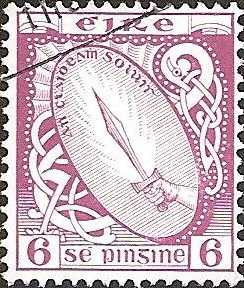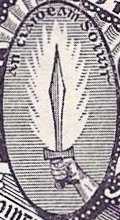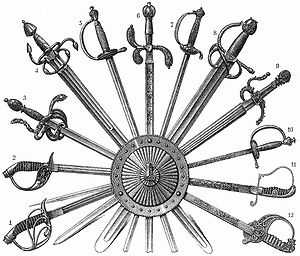Claíomh Solais

Claíomh Solais (reformed spelling), Claidheamh Soluis (unreformed Mod. Ir.)[1] (IPA:Irish pronunciation: [/kɫiːv ˈsɔɫɪʃ/]; an cloidheamh solais (variant spelling[2]) pronunc. roughly /kleeve-solish/), is an Irish term meaning "Sword of Light", or "Shining Sword", which appears in a number of orally transmitted Irish folk-tales esp. of the "adventure in the otherworld (giant's land)" variety. It also appears in numerous Scottish Gaelic folk-tales.[3]
Recent popularized notions equate this weapon with swords from Irish mythology (Cúchulainn's sword Cruaidín,[4] or Nuada's sword, one of the Four Treasures of the Tuatha Dé Danann), but this is not founded on solid literary evidence.
Overview
The folk tales featuring the claidheamh soluis typically compels the hero to perform (three) sets of tasks, aided by helpers, who may be a servant woman, "helpful animal companions", or some other supernatural being. The majority of are also bridal quests (or involve the winning of husbands in e.g., Maol a Chliobain[5]).
The adversary is usually described as a giant (guragach or fermór), who oftentimes cannot be defeated except by some secret means. Thus the hero or helper may resort to the sword of light as the only effective weapon against this enemy. But often the sword is not enough, and the supernatural enemy has to be attacked on a single vulnerable spot on his body. The weak spot, moreover, may be an external soul concealed somewhere in the world at large (inside animals, etc.), and in the case of "The Young King of Esaidh Ruadh",[6] this soul is encased within a nested series of animals.
The crucial secret to the hero's success is typically revealed by a woman, i.e., his would-be bride or the damsel in distress (the woman servant held captive by giants), etc. And even when the secret's revealant is an animal, she may in fact be a human transformed into beast (e.g. the great grey cat in "The Widow and her Daughters"[7]).
The woman as the possessor of the secret seems to be an element of preeminent importance, suggested by the fact that one tale bears the title "The Shining Sword and the Knowledge of the Cause of the One Story about Women" (and Kennedy's tale Fios Fath an aon Sceil or 'perfect narrative of the unique story'[8] may be a corruption of this). A parallel to this is the question "What is it that women most desire?" posed in the Arthurian tale of The Wedding of Sir Gawain and Dame Ragnelle, which may be a basis for further comparative analysis.
Irish Folktales
See under #Primary sources for bibliography of the compilations.
- "The Story of the Sculloge's son from Muskerry (Sceal Vhic Scoloige)" (Kennedy 1866, pp. 255-)
- "Fios Fath an aon Sceil" (perfect narrative of the unique story) (Kennedy 1866, pp. 266-)
- "The Weaver's Son and the Giant of the White Hill", (Curtin 1890, pp. 64–77). Here the "sword of sharpness".[9]
- "The Thirteenth Son of the King of Erin", (Curtin 1890, pp. 157–174)
- "Morraha; Brian More, son of the high-king of Erin, from the Well of Enchantments of Binn Edin" (Larminie 1893, pp. 10–30)
- "Simon and Margaret" (Larminie 1893, pp. 130–138)
- "Beauty of the World" (Larminie 1893, pp. 155–167)
- "The King who had Twelve Sons" (Larminie 1893, pp. 196–210)
- "Smallhead and the King's Sons" (Jacobs 1894, pp. 80–96 (No.XXXIX); Curtin, contrib. "Hero Tales of Ireland" (New York Sun))
- "The Shining Sword and the Knowledge of the Cause of the One Story about Women" (O'Faharta 1897, pp. 477–92 (ZCP 1))
- "The Snow, Crow, and the Blood" (MacManus 1900, pp. 151–174). This tale closely parallels another collected by Hyde entitled "Mac Riġ Eireann (The King of Ireland's Son)",[10] but in Hyde's version the hero's party obtains "the sword of the three edges" (cloiḋeaṁ na tri faoḃar).
- an untitled tale of Finn's three sons by the Queen of Italy collected at Glenties in Donegal, (Andrews 1919, pp. 91-)
- "An Claidheamh Soluis" (Ó Ceocháin 1927 (Béaloideas I, i (1927), pp. 277–282))
Scottish Gaelic Folktales
The publication of tales from the Highlands (Campbell 1860, Popular Tales of the West Highlands) predate the Irish tales becoming available in print. The magic sword sometimes appearing under variant names such as the "White Glave of Light" (Scottish Gaelic: an claidheamh geal soluis ).
- "The Young King of Esaidh Ruadh" (Campbell 1860, vol. I, pp.1-, No. 1;)
- "Widow's Son" (Campbell 1860, vol. I, pp.47-, No.2, 2nd variant;)
- "Tale of Conal Crovi" (Campbell 1860, vol. I, pp.125-, No.6; )
- "Tale of Connal" (Campbell 1860, vol. I, p.143-, No.7;)
- "Maol a Chliobain" (Campbell 1860, vol. I, pp.251-, No.17;)
- "The Widow and her Daughters" (Campbell 1860, vol. II, pp.265-, No.41, 2nd variant;)
- "Mac Iain Direach" (Campbell 1860, vol. II, pp.328-, No.46; )
- "An Sionnach, the Fox" (Campbell 1860, vol. II, pp.353-, No.46, 4th variant;)
- "The History of Kitty Ill-Pretts" (Bruford & MacDonald 1994, pp. 185–190, No. 21 )
There is also a Donegal tale ("Hung up Naked Man", summ. in English by Loomis; "Éamonn Ua Ciórrthais(?)" ed. Quiggin,) strikingly similar to the "Young King of Esaidh Ruadh" above, even though it does not mention a sword of light.[11][12]
Popular culture
In Gaming
A similar sword named Claimh Solais appears in Castlevania: Aria of Sorrow, and is considered one of the strongest weapons in the game, and stays hidden behind two secret passages in the Forbidden Area, it's in-game description says it's a "Sword with a sparkling blade", It also appears in Dawn of Sorrow and Harmony of Despair.
Commingling with mythological swords
The assertion that Claidheamh Soluis is "a symbol of Ireland attributed in oral tradition to Cúchulainn" (Mackillop[13]) does not seem very representative, since in the body of folktales that mention the sword of light (listed above), few (if any) names Cuchulainn as the protagonist. And T. F. O'Rahilly only went as far as to suggests that the "sword of light" in folk tales was a vestige of Cúchulainn's Cruaidín Catutchenn.[14] This sword (aka "Socht's sword") is said to have "shone at night like a candle" according to a version of Echtrae Cormaic ("Adventures of Cormac mac Airt").[15]
In some circles, the Claidheamh Soluis has been asserted to be the sword of Nuada Airgetlám, one of The Four Treasures of the Tuatha Dé Danann. This notion has become popular in Japan, where this information was disseminated by the fantasy related mythology reference.[16] It has been reported that artist Jim Fitzpatrick had been the one who identified Nuada's sword as the Claidheamh Soluis in his novels (Book of Conquests (1978), The Silver Arm (1981), and Érinsaga (1985)).
There is slim literary grounds for calling Nuada Airgedlamh's sword the Claidheamh Soluis. One scrap of text that might encourage the notion is found in the Scéla Conchobuir meic Nessa, where one of the eighteen shields (or swords[17]) of Ulstermen is called "the Candle of Nuada" (Irish: Chaindel Nuadat, Kinsella tr. "Nuadu's Cainnel—a bright torch").[18][19] This Nuada here is presumably an Ulster warrior but difficult to identify so that one is tempted to speculate the deity is meant.
Connection to other swords
Unsurprisingly, some have seen parallels with this to Excalibur, due to some of the descriptions regarding how it shone. When Excalibur was first drawn, in the first battle testing King Arthur's sovereignty, its blade blinded his enemies. Thomas Malory[20] writes: "thenne he drewe his swerd Excalibur, but it was so breyght in his enemyes eyen that it gaf light lyke thirty torchys."
Gallery
 1922/3 Definitive Stamp of Ireland (6 pence) showing An Claidheamh Soluis ("the sword of light") |
 1922/3 definitive Stamp of Ireland, 5 pence, detail, inscription reads "An Claiḋeaṁ Soluis" |
See also
Citations
- ↑ Mackillop 1998
- ↑ O'Rahilly 1946, EIHM, p.68; Kennedy
- ↑ Campbell 1860, I, 24, "The sword of light is common in Gaelic stories;.." etc.
- ↑ "the Divine Hero overcomes his father the Otherworld-god with that god's own weapon, the thunderolt, known variously in story-telling by names such as the Gaí Bulga (Cú Chulainn's weapon), the Caladbolg (Arthur's Escalibur), or the Claidheamh Soluis of our halfpenny postage-stamps." G.M., review of O'Rahilly 1946(EIHM), in: Studies, an Irish Quarterly Review; Vol. 35, No. 139 (Sep. 1946), pp. 420-422 JSTOR p.421
- ↑ Campbel 1860, vol. I, 251 (#17)
- ↑ Campbell 1860, vol. 1, pp.1-, (No.1)
- ↑ Campbell 1860, vol. II,265 (NO.41)
- ↑ Kennedy 1866, pp. 266-
- ↑ Also see notice in A.C.L. Brown, "Bleeding Lance", PMLA 25, p. 20
- ↑ in Hyde, Douglas (1890), Beside the Fire (INTERNET ARCHIVE), London: David Nutt, pp.18-47. Taken down from Seáġan O Cuineagáin (John Cunningham), village of Baile-an-phuill (Ballinphil), Co. Roscommon, half mile from Mayo. This tale is also closely summarized and analyzed for folk motives by Mackillop 1998, under "King of Ireland's Son"
- ↑ Loomis 1997, pp. 18-
- ↑ The Irish text is Edmund Crosby Quiggin, Dialect of Donegal (1906), 201 wikisource
- ↑ Mackillop 1998, Dict. Celtic Mythol.
- ↑ O'Rahilly 1946, EIHM, p. 68, "Cúchulainn possessed not only the spear of Bulga, but also a sword, known as in Cruaidín Catutchenn, which shone at night like a torch. In folk tales the lightning-sword has survived as "the sword of light" (an cloidheamh solais), possessed by a giant and won from him by a hero."
- ↑ p. 218, in: Stokes, Whitley, ed. tr., Scél na Fír Flatha, Echtra Chormaic i Tír Tairngiri ocus Cert Claidib Chormaic (the Irish Ordeals, Cormac's Adventure in the Land of Promise, and the Decision as to Cormac's Sword ), in Irische Texte III, 1 (Leipzig 1891) pp. 183–229.
- ↑ Takebe & Kaiheitai 1990, p. 58 and derivative literature. According Takebe's reference book, Nuadha wore a shining sword called the Claimh Solais (phonetisized Klau-Solas)—fiery sword, sword of light. The Claimh Solais was a magic sword carved with spells (runes), and reputedly an Undefeatable Sword such that once unsheathed, no one could escape its blows. And also, it was one of the Four Treasures of Erin brought from the mystical Isle of Findias in the North." Japanese: 「クラウ・ソラス(Claimh Solais - 炎の剣、光の剣)」と呼ばれる輝く剣を身につけていました。クラウ・ソラスは呪文が刻んである魔剣で、一度鞘から抜かれたら、その一撃から逃れられる者はいない不敗の剣であるとも伝えられています。そしてまた、北方にある神秘島のフィンジアス(Findias)市からもたらされた、エリン四至宝のうちの一つでした。 (p.58)
- ↑ Harry Mountain's Celtic Encyclopedia calls Cormac's Croda a sword, etc., Kinsella calls Leochain the hacking sword)
- ↑ Tr. ed. Scéla Conchobair maic Nessa "The Tidings of Conchobar son of Ness" in Ériu 4 (1910), 18–33. (books.google)
- ↑ Kinsella, "How Conchobar was begotten, and how he took the kingship of Ulster" in The Táin (1969). Kinsella uses the tale from the Book of Leinster here (rather than the 1st recension of TBC). See his endnotes.
- ↑ Book I, 19, from The Works of Sir Thomas Malory, Ed. Vinaver, Eugène, 3rd ed. Field, Rev. P. J. C. (1990). 3 vol. Oxford: Oxford University Press. ISBN 0-19-812344-2, ISBN 0-19-812345-0, ISBN 0-19-812346-9. (This is taken from the Winchester Manuscript).
References
Dictionaries
- * Mackillop, James (1998), Dictionary of Celtic Mytholgy, Oxford University Press, ISBN 0-19-280120-1
- Takebe, Nobuaki; Kaiheitai (1990), Koku no kamigami, Truth In Fantasy 6, Shin kigensha, ISBN 4-915146-24-3 (Japanese: 健部伸明と怪兵隊『虚空の神々』新紀元社)
Primary sources
- Collected orally, as told in English
- Kennedy, Patrick, ed. (1866), Legendary Fictions of the Irish Celts (GOOGLE), London: Macmillon and Co., sacred-texts (1891 ed.)
- Gaelic texts provided
- Campbell, J. F. (1860), Popular Tales of the West Highlands, Edingurgh: Edmonston and Douglas ([books.google]: Vol. I Vol. II) (Sacred-Texts site: Vol. 1 Vol. 2 Vol. 3 Vol. 4
- O'Faharta, D. (1897), "An Cloidheamh Soluis Agus Fios Fáth an Aon Sgeil ar na Mnáibh(The Shining Sword and the Knowledge of the Cause of the One Story about Women)" (GOOGLE), Zeitschrift für Celtische Philologie 1: 477–92 (ed., tr. in ZCP 1)
- Ó Ceocháin, Domhnall 1855-1966 (1927), "An Claidheamh Soluis", Béaloideas The Journal of Folklore of Ireland Society, 1, No.1: 277–(ed. tr. in Irish folklore journal; Iml[eabhar] 1, uimh[ir] 1, meitheamh 1927 [= Vol 1, No. 1, June 1927])
Secondary sources
- Translation only or Summaries
- Andrews, Elizabeth, ed. (1913), Ulster Folklore, London: Elliot Stock – via Gutenberg Project; (American edition, New York, E.P. Dutton, 1919) (google)
- Bruford, Alan J.; MacDonald, Donald A. (1994), Scottish Traditional Tales, Edinburgh: Polygon, pp. 185–190; Reprint, Edinburgh, Birlinn, 2003, 2007 "(questia)". Retrieved 2012-02-05.
- Campbell, J. F. (1891), The Celtic Dragon Myth (FORGOTTEN BOOKS)
- Curtin, Jeremiah, ed. (1890), Myths and Folk-Lore of Ireland, Boston: Little, Brown – via Google Books
- Jacobs, Joseph, ed. (1894), More Celtic Fairy Tales (WIKISOURCE); Internet Archives)
- Larminie, William (1893), West Irish Folk-Tales and Romances, London: Elliot Stock
Critical studies
- Loomis, Roger Sherman (1997), Celtic Myth and Arthurian Romance, Chicago: Academy Chicago Publishers, pp. 18ff
- O'Rahilly, T. F. (1946), Early Irish History and Mythology (SNIPPET), Dublin: Dublin Institute for Advanced Studies
Popularized versions
- MacManus, Seumas (1900), Donegal Fairy Stories, New York: McClure, Phillips & Co, pp. 157–174 – via Google Books
External links
| |||||||||||||||||||||||||||||||||
